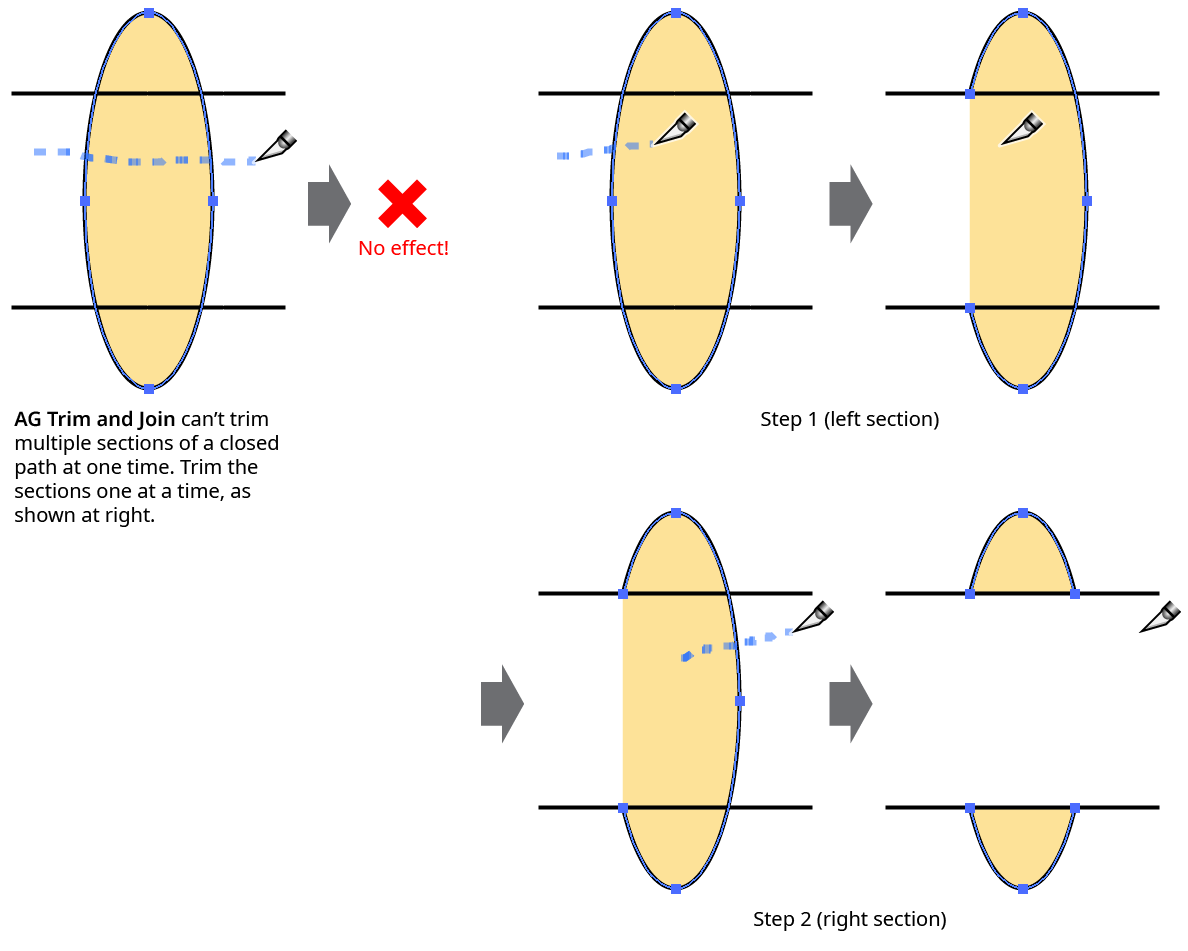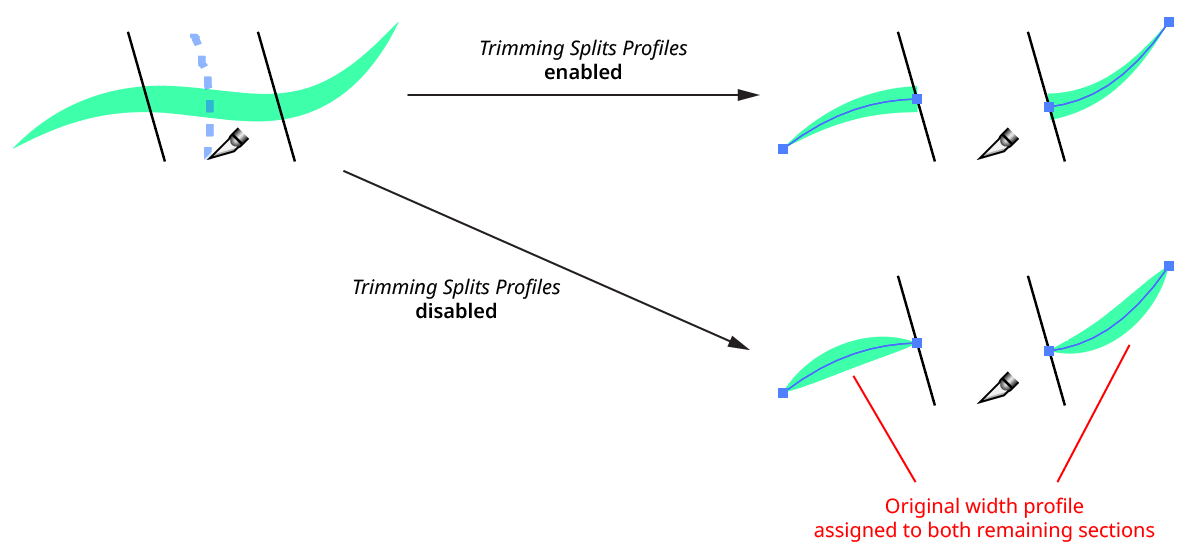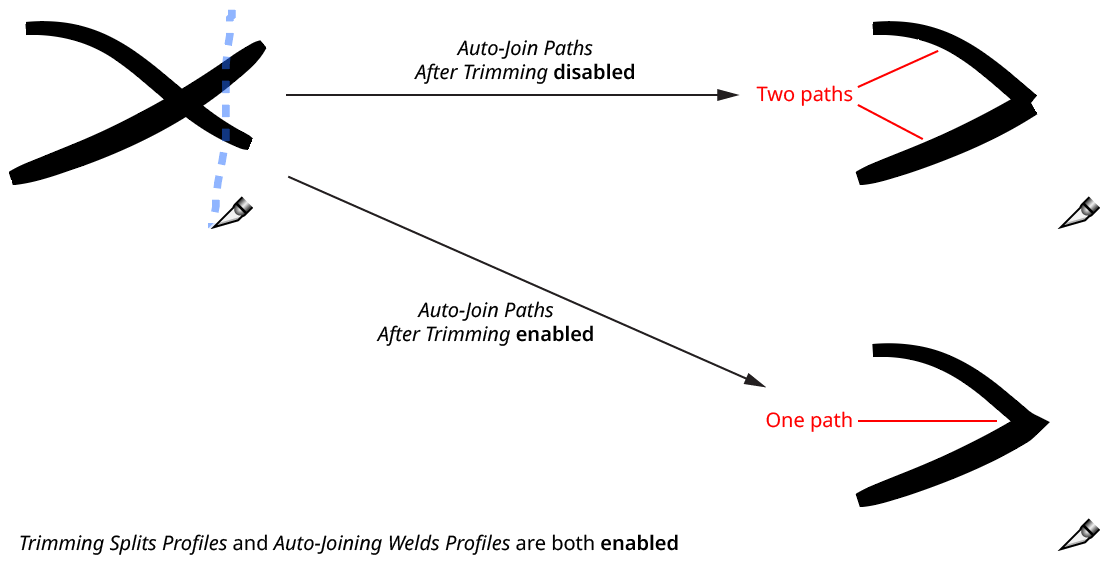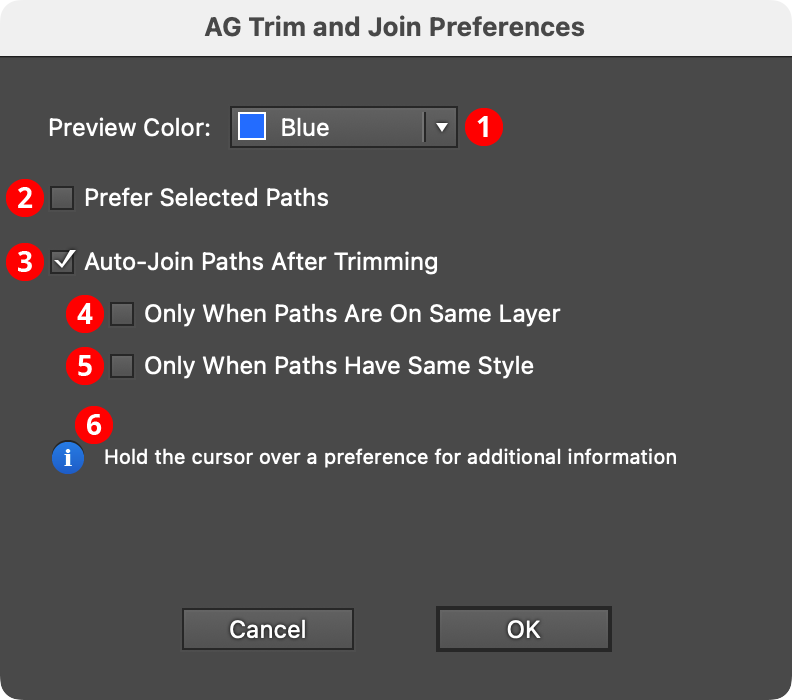 AG Trim and Join Tool
AG Trim and Join Tool
AG Trim and Join is an Astute Graphics tool for Adobe Illustrator that allows parts of paths to be trimmed simply by dragging over them. Optionally, it can automatically join together the resulting pieces to form new paths. AG Trim and Join is part of the DynamicSketch plugin.
Tool Location and Cursor Appearance
The AG Trim and Join tool appears in Illustrator’s main toolbar (which must be in Advanced mode: View > Toolbars > Advanced), stacked under the native Eraser and Scissors tools. As with other stacked tools, click and hold on the top tool icon to display the tools stacked under it.

AG Trim and Join Tool Location
The AG Trim and Join tool’s cursor looks like the tip of a precision utility knife:

AG Trim and Join Tool Cursor
AG Trim and Join Tool Operation
As the AG Trim and Join tool has several keypresses which can add or change its functionality, we suggest installing the free Astute Graphics plugin Astute Buddy, which creates a panel that dynamically updates to inform you of the various keys which can be pressed in the tool’s current context.
Much of the functionality of the AG Trim and Join tool is also available in the Dynamic Sketch tool. However, that tool requires the Shift modifier key to be pressed to enable trimming, and does not offer style-dependent joining.
To use the AG Trim and Join tool, simply drag it across a path, over the part that you want removed. A dashed line (blue by default) will show you the path of the tool. Cuts are made at the nearest intersection with another path, not at the position where the tool was dragged over the path:

AG Trim and Join Tool Trimming Example
Multiple paths may be trimmed in one pass:

AG Trim and Join Tool Trimming Multiple Paths Example
For closed paths to be trimmed, they must be intersected in at least two positions by another path (or must self-intersect). However, only one section of a closed path can be trimmed at a time:

AG Trim and Join Tool Trimming Closed Path Example
The path(s) to be trimmed need not be selected. However, if the preference Prefer Selected Paths is enabled, then when the tool is dragged across a mix of both selected and unselected paths, only the selected paths will be trimmed.
When a path with a variable width stroke is trimmed, by default AG Trim and Join attempts to retain the width profile(s) of the untrimmed section(s) as they existed prior to the trimming. This behavior may be adjusted using the tool preference Trimming Splits Profiles.

AG Trim and Join - Variable Width Stroke
If the tool preference Auto-Join Paths After Trimming is enabled, trimmed paths which contain an endpoint which is at the same spot as another path endpoint will be joined to that path (unless sub-preferences are set which only allow joining under certain circumstances; see AG Trim and Join: Preferences).

AG Trim and Join Tool - Auto-Join Paths Example
When paths with variable stroke widths are auto-joined, by default the stroke width profiles of each section will be preserved as best as possible, by “welding” together the profiles of each half. Note that this is in contrast to joining the paths with the native Command/Ctrl-J, which instead takes the entire stroke width profile for the joined path from the topmost of the original paths. However, the native behavior can be emulated using the tool preference Joining Welds Profiles.
Keypresses
While dragging the tool to trim a path, several keys may be pressed to held down for additional options:
Esc: Aborts the current trim operation (nothing will happen when the mouse button is released).
Option/Alt: Starts a “rubberband” section – a completely straight section that stretches between the point at which the modifier key was held down and the point at which it is released.
Shift: When creating a rubberband section, constrains the rubberband to angles that are 45° increments around the general constrain angle.
C: Changes the annotation color (for the dashed line preview) among the following choices: blue (default), red, magenta, green, cyan, and black.
D: Forces variable width profiles not to be split for the current operation, even when the preference is set to split them.
J: Forces joining of paths for the current operation, even when the preference is set to not join.
N: Forces no joining of paths for the current operation, even when the preference is set to join.
S: Forces variable width profiles to be split for the current operation, even when the preference is set to not split them.
AG Trim and Join Preferences
Doubleclicking the AG Trim and Join tool in the toolbox or pressing the Enter key when the tool is selected will bring up the AG Trim and Join preferences dialog:

AG Trim and Join Preferences
1. Preview Color
The menu allows a choice of annotation colors for the dashed preview line, from among blue (default), red, magenta, green, cyan, and black. This preference can be changed on the fly (while dragging) with the C key (each press of the key advances to the next color).
2. Prefer Selected Paths
When enabled, and tool is dragged across a mix of both selected and unselected paths, only the selected paths will be trimmed.
3. Auto-Join Paths After Trimming
Following the trim operation, trimmed paths with coincident endpoints will be detected and automatically joined, when possible (see AG Trim and Join: Tool Operation). When the preference is disabled, paths may still be joined for a single use of the tool by pressing the J key while dragging. When the preference is enabled, paths may still be kept from joining for a single use of the tool by pressing the N key while dragging.
4. Only When Paths Are On Same Layer
Available when Auto-Join Paths After Trimming is enabled, this preference ensures that joining will only occur if the trimmed paths are on the same layer.
5. Only When Paths Have Same Style
Available when Auto-Join Paths After Trimming is enabled, this pref- erence ensures that joining will only occur if the trimmed paths have the same style. When paths with different styles are joined, the style for the joined path is taken from the topmost of the pieces.

Auto-Join Only when Paths have Same Style Options
6. Trimming Splits Profiles
When enabled, trimmed paths with variable width strokes will have their width profiles split to try and preserve the look of the remaining section(s). This behavior can be overridden while using the tool by pressing either the D key (for “Force Don’t Split Width Profiles”) or the S key (for “Force Split Width Profiles”).
7. Auto-Joining Welds Profiles
When enabled, paths with variable width strokes that are auto-joined will receive a width profile that is composed of the two original paths’ profiles “welded” together; otherwise, the joined path receives the width profile of the topmost path (like the native Join command).
8. Informational area
Shows a brief description of each preference control when the cursor is being hovered over it.
9. Help Button
Opens the help documentation in the Astute Manager. If this does not automatically appear, please ensure your Astute Manager is running first.
